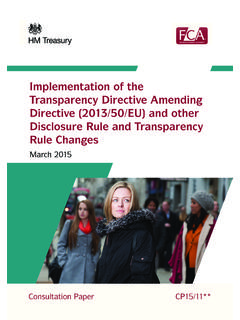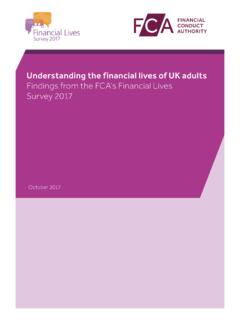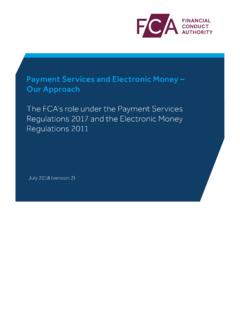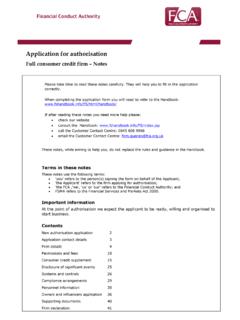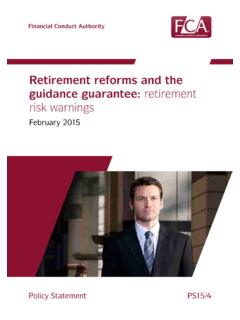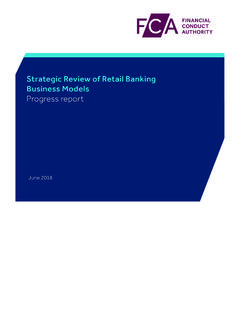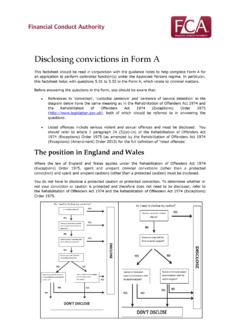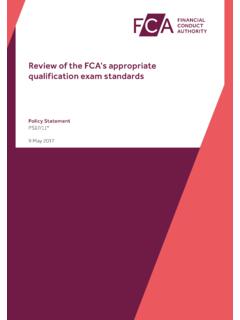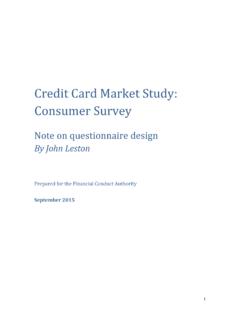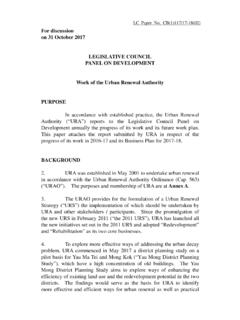Transcription of FS17/2: High-cost credit - Financial Conduct Authority
1 Feedback Statement F S17/ 2J u l y 2 017 High-cost creditIncluding review of the High-cost short-term credit price cap2F S17/ 2 Financial Conduct AuthorityHigh- cost creditIn this Feedback Statement we report on the main issues arising from Call for Input: High-cost credit Including review of the High-cost short-term credit price cap (published November 2016).Please send any comments or queries to:Terence Denness High-cost credit review Strategy & Competition DivisionFinancial Conduct Authority25 The North ColonnadeCanary WharfLondon E14 5 HSTelephone: 02 070 6 6176 8 Email: This relates toContents1 Summary 32 Review of the HCSTC price cap 83 high cost credit Review 254 Overdrafts 50 Annex 1 List of non-confidential respondents 67 Annex 2 Abbreviations used in this paper 71returns you to the contents listtakes you to helpful abbreviationsHow to navigate this document onscreen3 F S17/ 2 Chapter 1 Financial Conduct AuthorityHigh- cost credit1 SummaryWhat is this Feedback Statement about?
2 This Feedback Statement follows the Call for Input (CfI) that we issued in November last year. The CfI asked for views and evidence on potential areas of concern in the High-cost credit sector, including overdrafts. It also sought evidence relevant to our review of the price cap we set in 2015 on High-cost short-term credit (HCSTC). In this paper we set out our decision to maintain the price cap on HCSTC at its current level. That decision is based on the results of our analysis which we present in this paper which indicate the cap and other regulatory measures have been a success. We also commit to review the level of the cap again in three years time to ensure that it remains effective as the market We also set out our priorities for the next stage of our review of the High-cost credit sector. This includes an examination of both sector-wide issues and certain product-specific Across the sector, we have seen a consistent pattern of High-cost credit consumers credit ratings getting worse over time as they use the High-cost credit products.
3 We will examine this to understand both why this happens and what steps we can take to protect consumers from any harm that use of High-cost credit may cause. Drawing on our experience from the credit cards market, we will also consider long-term use of High-cost credit services and what we can do to ensure that consumers are not trapped in a long-term cycle of High-cost debt. We will also be looking at specific products in greater detail in our future work. These are rent-to-own services, home-collected credit and catalogue credit where we are aware of particular concerns. We have different concerns about both arranged and unarranged overdrafts. We have concerns about consumers long-term use of arranged overdrafts, at levels which are persistent, unsustainable, or both. Our concerns about unarranged overdrafts are also broader.
4 Their use is often inadvertent, and charges appear high and complex. Based on the evidence we have to date, we believe there is a case to consider the fundamental reform of unarranged overdrafts and consider whether they should have a place in any modern banking does this Feedback Statement apply to? Who needs to read this whole document? consumer credit lenders that provide HCSTC (Section 2), other types of High-cost credit lending (Section 3) or overdrafts (Section 4) 4F S17/ 2 Chapter 1 Financial Conduct AuthorityHigh- cost credit trade bodies representing these Who only needs to read this summary? other consumer credit firms and trade bodies, and consumer Who doesn t need to read this Feedback Statement, but it affects them? consumers who take out a High-cost loan or other credit wider context for this Feedback Statement In our CfI, published in November 2016, we gave an update on the significant changes in the HCSTC market and the improved outcomes for users of HCSTC.
5 We asked for evidence and views on whether we should make changes to the HCSTC price cap. 1 .11 We said we would look across High-cost credit products to build a full picture of how they are used, how different products may cause harm and, if so, to which consumers. This wide ranging review of High-cost credit enables us to consider whether we need to make further policy interventions and whether these should be more consistent than they currently are and applied across different markets. We also explained that we would use the review to look at arranged and unarranged overdrafts. This was due to identified competition issues and the nature and level of charges, especially for unarranged overdrafts. The review allows us to consider the related consumer protection issues using the full range of our We have separately published a Consultation Paper which proposes changes to our rules and guidance on assessing creditworthiness (including affordability) in consumer credit , to clarify our expectations of firms.
6 Our conclusions and next stepsHCSTC Price cap review We have concluded that we should keep the cap at its current level. We will review the level of the cap again in three years time. We have found improved outcomes for consumers since setting the cap. Consumers pay less, repay on time more often and are less likely to need help with HCSTC products from debt charities. Debt charities have also indicated that consumers are presenting themselves earlier and with lower debts, suggesting that underlying problems are being addressed sooner. We have seen a growth in firms offering longer term multiple instalment loans. CfI respondents note that there are benefits to spreading repayments over time, but that this increases the chances of missing payments. Our analysis is in line with this view. We see a rise in the number of loans with exactly one missed payment but an 5 F S17/ 2 Chapter 1 Financial Conduct AuthorityHigh- cost creditoverall drop in the default rate, indicating that the problems in repayment tend to be temporary and are resolved by the end of the loan period.
7 In future monitoring of this sector we will keep a close eye on the implications for consumers of the shift to longer-term instalment .17 We found no evidence that consumers who have not been able to get HCSTC products since the cap have generally had negative consequences as a result. The majority (63%) of consumers turned down for HCSTC products since the cap was introduced believe that they are better off as a result. We have not seen a significant waterbed effect with consumers increasing their use of other high cost credit products after failing to get a HCSTC loan. We also found no evidence that consumers who have been turned down for HCSTC are more likely to have subsequently used illegal money The market has got much smaller since 2014 and we expect further changes. However, many firms have been able to continue operating under the cap.
8 There has been a slight increase in the number and value of HCSTC loans issued since its low point in 2015 and we see some evidence of stronger competition within the market. We do not consider that the price cap is currently too tight. This is because firms are continuing to operate under the cap, and consumers who are declined for HCSTC do not generally appear to be harmed as a result. Additionally, HCSTC consumers have had improved outcomes which indicate that our interventions, including the price cap, have been of benefit. Many industry CfI respondents called for a period of regulatory stability. They also said that other areas of high cost credit had a greater risk of harm to consumers and should be higher priorities for any further work from us cost credit We have considered a wide array of products, including arranged and unarranged overdrafts and other High-cost credit services.
9 For clarity, while we have considered overdrafts together with other High-cost credit services, we discuss our concerns about overdrafts separately in Chapter We have identified a number of issues which could cause consumer harm. We will investigate these further with the aim of issuing a Consultation Paper on proposed solutions to our concerns in Spring 2018. We are particularly concerned about rent-to-own, home-collected credit and catalogue credit , as well as wider concerns about consumers long-term indebtedness. R e n t-to - o w n (RTO) Our initial findings highlight concerns about the high costs of RTO borrowing for this particularly vulnerable consumer group, and the consequences of that We will look in more depth at why consumers use RTO to obtain goods and whether more affordable alternatives are available. We will take a leading role in supporting collaboration to share best practice and foster innovative thinking and will convene a forum to encourage cross-agency public policy solutions, for example, how provision in this market could be enhanced through such schemes as social housing providers supplying essential S17/ 2 Chapter 1 Financial Conduct AuthorityHigh- cost We will also carry out a market-based analysis to understand and where possible address constraints that may currently prevent new entrants or other credit providers from increasing their supply of potentially cheaper credit to this vulnerable consumer group.
10 This will include considering whether this may be of broader application in other High-cost credit areas. Home-collected credit We have similar concerns to RTO about the potential for high levels of Financial distress experienced by longer-term borrowers. We will focus on particular features of the business model which may incentivise consumers long-term indebtedness and where we identify that this causes harm, explore options for potential action to protect consumers. These could include, for example, introducing restrictions on refinancing and rollovers, imposing time gaps between borrowing or time limits on the total duration of borrowing. Catalogue credit Our analysis raises concerns about the high level of arrears experienced by borrowers, with the fees and charges that are triggered by arrears, and the associated risk of Financial distress.
